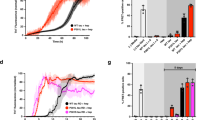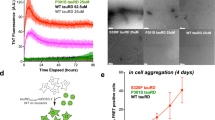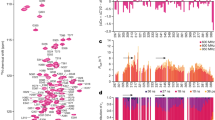Abstract
The self-propagation of misfolded conformations of tau underlies neurodegenerative diseases, including Alzheimer's. There is considerable interest in discovering the minimal sequence and active conformational nucleus that defines this self-propagating event. The microtubule-binding region, spanning residues 244–372, reproduces much of the aggregation behaviour of tau in cells and animal models. Further dissection of the amyloid-forming region to a hexapeptide from the third microtubule-binding repeat resulted in a peptide that rapidly forms fibrils in vitro. We show that this peptide lacks the ability to seed aggregation of tau244–372 in cells. However, as the hexapeptide is gradually extended to 31 residues, the peptides aggregate more slowly and gain potent activity to induce aggregation of tau244–372 in cells. X-ray fibre diffraction, hydrogen–deuterium exchange and solid-state NMR studies map the beta-forming region to a 25-residue sequence. Thus, the nucleus for self-propagating aggregation of tau244–372 in cells is packaged in a remarkably small peptide.
This is a preview of subscription content, access via your institution
Access options
Access Nature and 54 other Nature Portfolio journals
Get Nature+, our best-value online-access subscription
$29.99 / 30 days
cancel any time
Subscribe to this journal
Receive 12 print issues and online access
$259.00 per year
only $21.58 per issue
Buy this article
- Purchase on Springer Link
- Instant access to full article PDF
Prices may be subject to local taxes which are calculated during checkout





Similar content being viewed by others
References
Prusiner, S. B. A unifying role for prions in neurodegenerative diseases. Science 336, 1511–1513 (2012).
Sanders, D. W. et al. Distinct tau prion strains propagate in cells and mice and define different tauopathies. Neuron 82, 1271–1288 (2014).
Braak, H. & Braak, E. Staging of Alzheimer's disease-related neurofibrillary changes. Neurobiol. Aging 16, 271–284 (1995).
Clavaguera, F. et al. Brain homogenates from human tauopathies induce tau inclusions in mouse brain. Proc. Natl Acad. Sci. USA 110, 9535–9540 (2013).
Boluda, S. et al. Differential induction and spread of tau pathology in young PS19 tau transgenic mice following intracerebral injections of pathological tau from Alzheimer's disease or corticobasal degeneration brains. Acta Neuropathol. 129, 221–237 (2015).
Wang, Y. & Mandelkow, E. Tau in physiology and pathology. Nat. Rev. Neurosci. 17, 5–21 (2016).
Morris, M. et al. Tau post-translational modifications in wild-type and human amyloid precursor protein transgenic mice. Nat. Neurosci. 18, 1183–1189 (2015).
Goedert, M., Falcon, B., Clavaguera, F. & Tolnay, M. Prion-like mechanisms in the pathogenesis of tauopathies and synucleinopathies. Curr. Neurol. Neurosci. Rep. 14, 495-491–495-411 (2014).
Wischik, C. M. et al. Structural characterization of the core of the paired helical filament of Alzheimer disease. Proc. Natl Acad. Sci. USA 85, 4884–4888 (1988).
Wille, H., Drewes, G., Biernat, J., Mandelkow, E.-M. & Mandelkow, E. Alzheimer-like paired helical filaments and antiparallel dimers formed from microtubule-associated protein tau in vitro. J. Cell. Biol. 118, 573–584 (1992).
von Bergen, M. et al. Assembly of τ protein into Alzheimer paired helical filaments depends on a local sequence motif ((306)VQIVYK)311)) forming β structure. Proc. Natl Acad. Sci. USA 97, 5129–5134 (2000).
Sawaya, M. R. et al. Atomic structures of amyloid cross-β spines reveal varied steric zippers. Nature 447, 453–457 (2007).
Sievers, S. A. et al. Structure-based design of non-natural amino-acid inhibitors of amyloid fibril formation. Nature 475, 96–100 (2011).
Daebel, V. et al. β-sheet core of tau paired helical filaments revealed by solid-state NMR. J. Am. Chem. Soc. 134, 13982–13989 (2012).
Tomoo, K. et al. Possible role of each repeat structure of the microtubule-binding domain of the tau protein in in vitro aggregation. J. Biochem. 138, 413–423 (2005).
Adamcik, J. et al. Microtubule-binding R3 fragment from tau self-assembles into giant multistranded amyloid ribbons. Angew. Chem. Int. Ed. 55, 618–622 (2016).
LeVine, H. Thioflavine T interaction with synthetic Alzheimer's disease b-amyloid peptides: detection of amyloid aggregation in solution. Protein Sci. 2, 404–410 (1993).
Goedert, M. et al. Assembly of microtubule-associated protein tau into Alzheimer-like filaments induced by sulphated glycosaminoglycans. Nature 383, 550–553 (1996).
Wilson, D. M. & Binder, L. I. Free fatty acids stimulate the polymerization of tau and amyloid beta peptides. In vitro evidence for a common effector of pathogenesis in Alzheimer's disease. Am. J. Pathol. 150, 2181–2195 (1997).
Woerman, A. L. et al. Propagation of prions causing synucleinopathies in cultured cells. Proc. Natl Acad. Sci. USA 112, E4949–E4958 (2015).
Furukawa, Y., Kaneko, K. & Nukina, N. Tau protein assembles into isoform- and disulfide-dependent polymorphic fibrils with distinct structural properties. J. Biol. Chem. 286, 27236–27246 (2011).
Soeda, Y. et al. Toxic tau oligomer formation blocked by capping of cysteine residues with 1,2-dihydroxybenzene groups. Nat. Commun. 6, 10216 (2015).
Bhattacharya, K., Rank, K. B., Evans, D. B. & Sharma, S. K. Role of cysteine-291 and cysteine-322 in the polymerization of human tau into Alzheimer-like filaments. Biochem. Biophys. Res. Commun. 285, 20–26 (2001).
Barghorn, S. & Mandelkow, E. Toward a unified scheme for the aggregation of tau into Alzheimer paired helical filaments. Biochemistry 41, 14885–14896 (2002).
Velasco, A. et al. Detection of filamentous tau inclusions by the fluorescent Congo red derivative FSB [(trans,trans)-1-fluoro-2,5-bis(3-hydroxycarbonyl-4-hydroxy)styrylbenzene]. FEBS Lett. 582, 901–906 (2008).
Harada, R. et al. Use of a benzimidazole derivative BF-188 in fluorescence multispectral imaging for selective visualization of tau protein fibrils in the Alzheimer's disease brain. Mol. Imaging Biol. 16, 19–27 (2014).
Astbury, W. T., Dickinson, S. & Bailey, K. CCLXXIX. The X-ray interpretation of denaturation and the structure of the seed globulins. Biochem. J. 29, 2351–2361 (1935).
Wille, H. et al. Natural and synthetic prion structure from X-ray fiber diffraction. Proc. Natl Acad. Sci. USA 106, 16990–16995 (2009).
Jahn, T. R. et al. The common architecture of cross-beta amyloid. J. Mol. Biol. 395, 717–727 (2010).
Wan, W. et al. Degradation of fungal prion HET-s(218-289) induces formation of a generic amyloid fold. Biophys. J. 102, 2339–2344 (2012).
Wan, W. et al. Heterogeneous seeding of a prion structure by a generic amyloid form of the fungal prion-forming domain HET-s(218–289). J. Biol. Chem. 288, 29604–29612 (2013).
Legname, G. et al. Continuum of prion protein structures enciphers a multitude of prion isolate-specified phenotypes. Proc. Natl Acad. Sci. USA 103, 19105–19110 (2006).
Zhang, Y.-Z., Paterson, Y. & Roder, H. Rapid amide proton exchange rates in peptides and proteins measured by solvent quenching and two-dimensional NMR. Protein Sci. 4, 804–814 (1995).
Takegoshi, K., Nakamura, S. & Terao, T. 13C–1H dipolar-driven 13C–13C recoupling without 13C rf irradiation in nuclear magnetic resonance of rotating solids. J. Chem. Phys. 118, 2325–2341 (2003).
Wang, Y. & Jardetzky, O. Probability-based protein secondary structure identification using combined NMR chemical-shift data. Protein Sci. 11, 852–861 (2002).
Ritter, C. et al. Correlation of structural elements and infectivity of the HET-s prion. Nature 435, 844–848 (2005).
Takada, L. T. & Geschwind, M. D. Prion diseases. Semin. Neurol. 33, 348–356 (2013).
Wan, W., Stöhr, J., Kendall, A. & Stubbs, G. Truncated forms of the prion protein PrP demonstrate the need for complexity in prion structure. Prion 9, 333–338 (2015).
Acknowledgements
J.S., W.F.D., H.W., M.N. and S.B.P. are supported by grants from the National Institutes of Health (AG002132, AG031220, GM054616 and HL007731). J.S. and M.N. were supported by an award from the Glenn Foundation. J.S. is a recipient of the New Investigator Research Grant (2015-NIRG-339935) from the Alzheimer's Association. F.G. and J.R. are supported by a grant from the National Institutes of Health (GM104605). This work was also supported in part by the UCSF Research Resource Program Shared Equipment Award funded by the UCSF Office of Research, Daiichi Sankyo, the Henry M. Jackson Foundation, the Sherman Fairchild Foundation, and by a gift from the Rainwater Charitable Foundation.
Author information
Authors and Affiliations
Contributions
J.S., W.F.D. and S.B.P. conceived and designed the experiments; J.S., M.N., H.W., M.B., C.C., N.J., J.R., T.L., S.A., J.B., M.J.S.K. and K.R. performed the experiments; J.S., M.N., H.W.Y.W., M.B. and C.C analysed data; J.S., W.F.D. and S.B.P. co-wrote the paper; J.S., M.N. and H.W. contributed equally to this work.
Corresponding authors
Ethics declarations
Competing interests
UCSF is conducting research sponsored by Daiichi Sankyo (Tokyo, Japan) to develop diagnostics and therapeutics for tau. Currently, there is no direct relationship between these agreements and this Article.
Supplementary information
Supplementary information
Supplementary information (PDF 32670 kb)
Rights and permissions
About this article
Cite this article
Stöhr, J., Wu, H., Nick, M. et al. A 31-residue peptide induces aggregation of tau's microtubule-binding region in cells. Nature Chem 9, 874–881 (2017). https://doi.org/10.1038/nchem.2754
Received:
Accepted:
Published:
Issue Date:
DOI: https://doi.org/10.1038/nchem.2754



